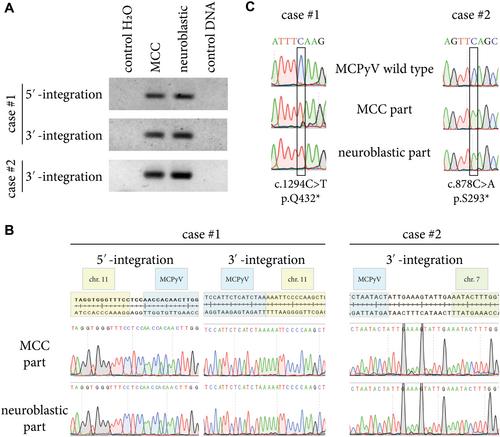Thibault Kervarrec, Silke Appenzeller, Susanne Gramlich, Etienne Coyaud, Kamel Bachiri, Romain Appay, Nicolas Macagno, Anne Tallet, Christine Bonenfant, Yannick Lecorre, Jean Kapfer, Sami Kettani, Nalini Srinivas, Kuan Cheok Lei, Anja Lange, Jürgen C Becker, Eva Maria Sarosi, Hervé Sartelet, Andreas von Deimling, Antoine Touzé, Serge Guyétant, Mahtab Samimi, David Schrama, Roland Houben
下载PDF
{"title":"对含有神经母细胞成分的合并梅克尔细胞癌的分析表明,梅克尔细胞癌中 T 抗原表达的缺失可能会导致细胞周期停滞和神经母细胞的转分化。","authors":"Thibault Kervarrec, Silke Appenzeller, Susanne Gramlich, Etienne Coyaud, Kamel Bachiri, Romain Appay, Nicolas Macagno, Anne Tallet, Christine Bonenfant, Yannick Lecorre, Jean Kapfer, Sami Kettani, Nalini Srinivas, Kuan Cheok Lei, Anja Lange, Jürgen C Becker, Eva Maria Sarosi, Hervé Sartelet, Andreas von Deimling, Antoine Touzé, Serge Guyétant, Mahtab Samimi, David Schrama, Roland Houben","doi":"10.1002/path.6304","DOIUrl":null,"url":null,"abstract":"<p>Merkel cell carcinoma (MCC) is an aggressive skin cancer frequently caused by genomic integration of the Merkel cell polyomavirus (MCPyV). MCPyV-negative cases often present as combined MCCs, which represent a distinctive subset of tumors characterized by association of an MCC with a second tumor component, mostly squamous cell carcinoma. Up to now, only exceptional cases of combined MCC with neuroblastic differentiation have been reported. Herein we describe two additional combined MCCs with neuroblastic differentiation and provide comprehensive morphologic, immunohistochemical, transcriptomic, genetic and epigenetic characterization of these tumors, which both arose in elderly men and appeared as an isolated inguinal adenopathy. Microscopic examination revealed biphasic tumors combining a poorly differentiated high-grade carcinoma with a poorly differentiated neuroblastic component lacking signs of proliferation. Immunohistochemical investigation revealed keratin 20 and MCPyV T antigen (TA) in the MCC parts, while neuroblastic differentiation was confirmed in the other component in both cases. A clonal relation of the two components can be deduced from 20 and 14 shared acquired point mutations detected by whole exome analysis in both combined tumors, respectively. Spatial transcriptomics demonstrated a lower expression of stem cell marker genes such as <i>SOX2</i> and <i>MCM2</i> in the neuroblastic component. Interestingly, although the neuroblastic part lacked TA expression, the same genomic MCPyV integration and the same large T-truncating mutations were observed in both tumor parts. Given that neuronal transdifferentiation upon TA repression has been reported for MCC cell lines, the most likely scenario for the two combined MCC/neuroblastic tumors is that neuroblastic transdifferentiation resulted from loss of TA expression in a subset of MCC cells. Indeed, DNA methylation profiling suggests an MCC-typical cellular origin for the combined MCC/neuroblastomas. © 2024 The Author(s). <i>The Journal of Pathology</i> published by John Wiley & Sons Ltd on behalf of The Pathological Society of Great Britain and Ireland.</p>","PeriodicalId":232,"journal":{"name":"The Journal of Pathology","volume":"264 1","pages":"112-124"},"PeriodicalIF":5.2000,"publicationDate":"2024-07-25","publicationTypes":"Journal Article","fieldsOfStudy":null,"isOpenAccess":false,"openAccessPdf":"https://onlinelibrary.wiley.com/doi/epdf/10.1002/path.6304","citationCount":"0","resultStr":"{\"title\":\"Analyses of combined Merkel cell carcinomas with neuroblastic components suggests that loss of T antigen expression in Merkel cell carcinoma may result in cell cycle arrest and neuroblastic transdifferentiation\",\"authors\":\"Thibault Kervarrec, Silke Appenzeller, Susanne Gramlich, Etienne Coyaud, Kamel Bachiri, Romain Appay, Nicolas Macagno, Anne Tallet, Christine Bonenfant, Yannick Lecorre, Jean Kapfer, Sami Kettani, Nalini Srinivas, Kuan Cheok Lei, Anja Lange, Jürgen C Becker, Eva Maria Sarosi, Hervé Sartelet, Andreas von Deimling, Antoine Touzé, Serge Guyétant, Mahtab Samimi, David Schrama, Roland Houben\",\"doi\":\"10.1002/path.6304\",\"DOIUrl\":null,\"url\":null,\"abstract\":\"<p>Merkel cell carcinoma (MCC) is an aggressive skin cancer frequently caused by genomic integration of the Merkel cell polyomavirus (MCPyV). MCPyV-negative cases often present as combined MCCs, which represent a distinctive subset of tumors characterized by association of an MCC with a second tumor component, mostly squamous cell carcinoma. Up to now, only exceptional cases of combined MCC with neuroblastic differentiation have been reported. Herein we describe two additional combined MCCs with neuroblastic differentiation and provide comprehensive morphologic, immunohistochemical, transcriptomic, genetic and epigenetic characterization of these tumors, which both arose in elderly men and appeared as an isolated inguinal adenopathy. Microscopic examination revealed biphasic tumors combining a poorly differentiated high-grade carcinoma with a poorly differentiated neuroblastic component lacking signs of proliferation. Immunohistochemical investigation revealed keratin 20 and MCPyV T antigen (TA) in the MCC parts, while neuroblastic differentiation was confirmed in the other component in both cases. A clonal relation of the two components can be deduced from 20 and 14 shared acquired point mutations detected by whole exome analysis in both combined tumors, respectively. Spatial transcriptomics demonstrated a lower expression of stem cell marker genes such as <i>SOX2</i> and <i>MCM2</i> in the neuroblastic component. Interestingly, although the neuroblastic part lacked TA expression, the same genomic MCPyV integration and the same large T-truncating mutations were observed in both tumor parts. Given that neuronal transdifferentiation upon TA repression has been reported for MCC cell lines, the most likely scenario for the two combined MCC/neuroblastic tumors is that neuroblastic transdifferentiation resulted from loss of TA expression in a subset of MCC cells. Indeed, DNA methylation profiling suggests an MCC-typical cellular origin for the combined MCC/neuroblastomas. © 2024 The Author(s). <i>The Journal of Pathology</i> published by John Wiley & Sons Ltd on behalf of The Pathological Society of Great Britain and Ireland.</p>\",\"PeriodicalId\":232,\"journal\":{\"name\":\"The Journal of Pathology\",\"volume\":\"264 1\",\"pages\":\"112-124\"},\"PeriodicalIF\":5.2000,\"publicationDate\":\"2024-07-25\",\"publicationTypes\":\"Journal Article\",\"fieldsOfStudy\":null,\"isOpenAccess\":false,\"openAccessPdf\":\"https://onlinelibrary.wiley.com/doi/epdf/10.1002/path.6304\",\"citationCount\":\"0\",\"resultStr\":null,\"platform\":\"Semanticscholar\",\"paperid\":null,\"PeriodicalName\":\"The Journal of Pathology\",\"FirstCategoryId\":\"3\",\"ListUrlMain\":\"https://pathsocjournals.onlinelibrary.wiley.com/doi/10.1002/path.6304\",\"RegionNum\":2,\"RegionCategory\":\"医学\",\"ArticlePicture\":[],\"TitleCN\":null,\"AbstractTextCN\":null,\"PMCID\":null,\"EPubDate\":\"\",\"PubModel\":\"\",\"JCR\":\"Q1\",\"JCRName\":\"ONCOLOGY\",\"Score\":null,\"Total\":0}","platform":"Semanticscholar","paperid":null,"PeriodicalName":"The Journal of Pathology","FirstCategoryId":"3","ListUrlMain":"https://pathsocjournals.onlinelibrary.wiley.com/doi/10.1002/path.6304","RegionNum":2,"RegionCategory":"医学","ArticlePicture":[],"TitleCN":null,"AbstractTextCN":null,"PMCID":null,"EPubDate":"","PubModel":"","JCR":"Q1","JCRName":"ONCOLOGY","Score":null,"Total":0}
引用次数: 0
引用
批量引用



 求助内容:
求助内容: 应助结果提醒方式:
应助结果提醒方式:


